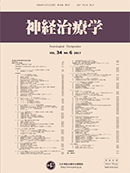Volume 35, Issue 2
Displaying 1-16 of 16 articles from this issue
- |<
- <
- 1
- >
- >|
-
2018Volume 35Issue 2 Pages 77
Published: 2018
Released on J-STAGE: August 31, 2018
Download PDF (202K)
-
2018Volume 35Issue 2 Pages 79-82
Published: 2018
Released on J-STAGE: August 31, 2018
Download PDF (449K)
-
2018Volume 35Issue 2 Pages 83-85
Published: 2018
Released on J-STAGE: August 31, 2018
Download PDF (1978K) -
2018Volume 35Issue 2 Pages 86-91
Published: 2018
Released on J-STAGE: August 31, 2018
Download PDF (4442K) -
2018Volume 35Issue 2 Pages 92-95
Published: 2018
Released on J-STAGE: August 31, 2018
Download PDF (1473K) -
2018Volume 35Issue 2 Pages 96-98
Published: 2018
Released on J-STAGE: August 31, 2018
Download PDF (395K) -
2018Volume 35Issue 2 Pages 99-103
Published: 2018
Released on J-STAGE: August 31, 2018
Download PDF (471K) -
2018Volume 35Issue 2 Pages 104-107
Published: 2018
Released on J-STAGE: August 31, 2018
Download PDF (449K) -
2018Volume 35Issue 2 Pages 108-112
Published: 2018
Released on J-STAGE: August 31, 2018
Download PDF (2390K)
-
2018Volume 35Issue 2 Pages 113-117
Published: 2018
Released on J-STAGE: August 31, 2018
Download PDF (650K)
-
2018Volume 35Issue 2 Pages 118-121
Published: 2018
Released on J-STAGE: August 31, 2018
Download PDF (1936K) -
2018Volume 35Issue 2 Pages 122-126
Published: 2018
Released on J-STAGE: August 31, 2018
Download PDF (1105K)
-
2018Volume 35Issue 2 Pages 127-128
Published: 2018
Released on J-STAGE: August 31, 2018
Download PDF (1277K)
-
2018Volume 35Issue 2 Pages 129-132
Published: 2018
Released on J-STAGE: August 31, 2018
Download PDF (381K) -
2018Volume 35Issue 2 Pages 133
Published: 2018
Released on J-STAGE: August 31, 2018
Download PDF (217K) -
2018Volume 35Issue 2 Pages 134
Published: 2018
Released on J-STAGE: August 31, 2018
Download PDF (208K)
- |<
- <
- 1
- >
- >|
